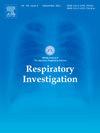Differences between influenza and COVID-19 patients who required hospitalization: A study of the 2024–2025 season
IF 2
Q2 RESPIRATORY SYSTEM
引用次数: 0
Abstract
Background
During the winter and spring of 2024–2025, severe acute respiratory syndrome coronavirus 2 (SARS-CoV-2) XEC subvariant became the main cause of the epidemic, and at the same time, major influenza epidemics were also observed. To clarify the differences between COVID-19 and influenza, we conducted a comparative study of patients who required hospitalization during the same period.
Methods
We compared 193 patients with COVID-19 Omicron XEC subvariant and 98 patients with influenza H1N1 pdm09 who required hospitalization.
Results
The following characteristics were significantly more common in the COVID-19 group than in the influenza group: 1) males, 2) patients with chronic kidney disease, malignant tumors, autoimmune diseases, and patients using immunosuppressants, 3) patients with multiple underlying diseases, 4) healthcare-associated pneumonia, 5) pure viral pneumonia, 6) aspiration pneumonia, 7) cases in which antivirals had not been used since the diagnosis of infection, 8) patients who required invasive mechanical ventilation management or intensive care unit admission, and 9) deaths. On the other hand, the following characteristics were significantly more frequently observed in the influenza group than in the COVID-19 group: 1) patients without underlying diseases, 2) patients who had been vaccinated within the past year, 3) community-acquired pneumonia, and 4) mixed bacterial pneumonia.
Conclusions
There were many differences between the COVID-19 group and the influenza group that required hospitalization. The rates of severe illness and mortality in the elderly remain high in the COVID-19 group.
需要住院治疗的流感和COVID-19患者之间的差异:2024-2025年季节的研究
背景:2024-2025年冬季和春季,SARS-CoV-2 (SARS-CoV-2) XEC亚型成为疫情的主要病原,同时也出现了重大流感流行。为了弄清COVID-19和流感之间的差异,我们对同一时期需要住院治疗的患者进行了比较研究。方法:我们比较了193例COVID-19 Omicron XEC亚变体患者和98例需要住院治疗的H1N1流感pdm09患者。结果:以下特征在COVID-19组中比在流感组中更常见:1)男性,2)慢性肾脏疾病、恶性肿瘤、自身免疫性疾病和使用免疫抑制剂的患者,3)多重基础疾病患者,4)卫生保健相关肺炎,5)纯病毒性肺炎,6)吸入性肺炎,7)诊断感染后未使用抗病毒药物的病例,8)需要有创机械通气管理或入住重症监护病房的患者,9)死亡。另一方面,流感组的以下特征明显高于COVID-19组:1)无基础疾病患者,2)近一年内接种过疫苗的患者,3)社区获得性肺炎,4)混合细菌性肺炎。结论:COVID-19组与需要住院治疗的流感组存在许多差异。在COVID-19组中,老年人的重症发病率和死亡率仍然很高。
本文章由计算机程序翻译,如有差异,请以英文原文为准。
求助全文
约1分钟内获得全文
求助全文

 求助内容:
求助内容: 应助结果提醒方式:
应助结果提醒方式:


